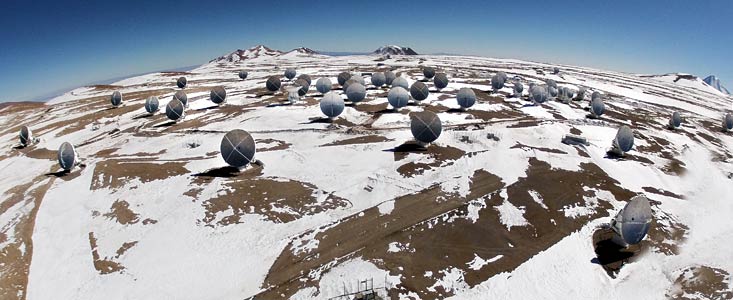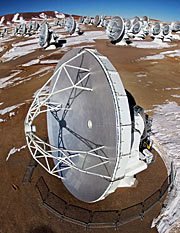Anuncio
Primeras imágenes aéreas de ALMA en pleno funcionamiento
31 de Julio de 2013
Toda la magnitud del Observatorio ALMA se devela en estas nuevas y espectaculares imágenes del conjunto de antenas, rodeado de nieve en el llano de Chajnantor, localizado al norte de Chile. Las fotografías fueron captadas recientemente a través de una cámara instalada en un hexacóptero.
El vuelo, registrado como un récord mundial Guinness para aeronaves multi-rotor a gran altura, se logró gracias a la ligera plataforma de fibra de carbono de la nave controlada a distancia. El hexacóptero, que posee seis conjuntos de rotores, también cuenta con funciones autónomas que ayudan a la navegación y permiten que éste regrese a su punto de partida en caso de perder la señal.
"Antes de que llegáramos al sitio de ALMA no existía registro de que algún artefacto similar hubiese volado a tal altura. La baja presión atmosférica hace que la elevación generada por las hélices sea considerablemente inferior", afirma el fotógrafo Ariel Marinkovic, quien dirigió la sesión fotográfica.
La única solución era reducir el peso del hexacóptero tanto como fuera posible. Para lograrlo, se decidió retirar el armazón y el tren de aterrizaje, y reemplazarlos por una estructura más liviana. Además, se hizo uso de una pequeña cámara de apenas 200 gramos, reduciendo el peso total en 1,2 kilogramos.
Pero existía otro desafío: las bajas temperaturas (alrededor de -3 grados centígrados a 5.000 metros sobre el nivel del mar, donde se encuentran las antenas de ALMA) podrían hacer que el hexacóptero perdiese hasta el 70% de su potencia. Para evitarlo, se instaló un recubrimiento hecho de aluminio y tela térmica alrededor de sus baterías.
"Fue una verdadera apuesta: el hexacóptero estaba diseñado para volar a unos 4.500 metros por debajo de la altura del sitio de ALMA. Los cálculos realizados sugerían que no sería posible que despegara," recuerda Marinkovic. Sin embargo, sentía que valía la pena intentarlo: "en un viaje anterior a 4.200 metros sobre el nivel del mar, pude ver algunas gaviotas, y pensé que un ave no volaría en un lugar donde tuviese que usar el 90% de su energía sólo para encontrar su próxima comida".
Esta lógica resultó ser correcta y las primeras imágenes aéreas de ALMA, desde su inauguración oficial en marzo de 2013, fueron captadas con éxito.Este evento trae a la memoria el origen del nombre de Chajnantor, que para el pueblo atacameño (los habitantes originarios de la región) significa "lugar de partida".
Contactos
Richard Hook
ESO, Public Information Officer
Garching bei München, Germany
Tel: +49 89 3200 6655
Cell: +49 151 1537 3591
Email: rhook@eso.org
Sobre el anuncio
| Identificador: | ann13064 |
Our use of Cookies
We use cookies that are essential for accessing our websites and using our services. We also use cookies to analyse, measure and improve our websites’ performance, to enable content sharing via social media and to display media content hosted on third-party platforms.
ESO Cookies Policy
The European Organisation for Astronomical Research in the Southern Hemisphere (ESO) is the pre-eminent intergovernmental science and technology organisation in astronomy. It carries out an ambitious programme focused on the design, construction and operation of powerful ground-based observing facilities for astronomy.
This Cookies Policy is intended to provide clarity by outlining the cookies used on the ESO public websites, their functions, the options you have for controlling them, and the ways you can contact us for additional details.
What are cookies?
Cookies are small pieces of data stored on your device by websites you visit. They serve various purposes, such as remembering login credentials and preferences and enhance your browsing experience.
Categories of cookies we use
Essential cookies (always active): These cookies are strictly necessary for the proper functioning of our website. Without these cookies, the website cannot operate correctly, and certain services, such as logging in or accessing secure areas, may not be available; because they are essential for the website’s operation, they cannot be disabled.
Functional Cookies: These cookies enhance your browsing experience by enabling additional features and personalization, such as remembering your preferences and settings. While not strictly necessary for the website to function, they improve usability and convenience; these cookies are only placed if you provide your consent.
Analytics cookies: These cookies collect information about how visitors interact with our website, such as which pages are visited most often and how users navigate the site. This data helps us improve website performance, optimize content, and enhance the user experience; these cookies are only placed if you provide your consent. We use the following analytics cookies.
Matomo Cookies:
This website uses Matomo (formerly Piwik), an open source software which enables the statistical analysis of website visits. Matomo uses cookies (text files) which are saved on your computer and which allow us to analyze how you use our website. The website user information generated by the cookies will only be saved on the servers of our IT Department. We use this information to analyze www.eso.org visits and to prepare reports on website activities. These data will not be disclosed to third parties.
On behalf of ESO, Matomo will use this information for the purpose of evaluating your use of the website, compiling reports on website activity and providing other services relating to website activity and internet usage.
Matomo cookies settings:
Additional Third-party cookies on ESO websites: some of our pages display content from external providers, e.g. YouTube.
Such third-party services are outside of ESO control and may, at any time, change their terms of service, use of cookies, etc.
YouTube: Some videos on the ESO website are embedded from ESO’s official YouTube channel. We have enabled YouTube’s privacy-enhanced mode, meaning that no cookies are set unless the user actively clicks on the video to play it. Additionally, in this mode, YouTube does not store any personally identifiable cookie data for embedded video playbacks. For more details, please refer to YouTube’s embedding videos information page.
Cookies can also be classified based on the following elements.
Regarding the domain, there are:
- First-party cookies, set by the website you are currently visiting. They are stored by the same domain that you are browsing and are used to enhance your experience on that site;
- Third-party cookies, set by a domain other than the one you are currently visiting.
As for their duration, cookies can be:
- Browser-session cookies, which are deleted when the user closes the browser;
- Stored cookies, which stay on the user's device for a predetermined period of time.
How to manage cookies
Cookie settings: You can modify your cookie choices for the ESO webpages at any time by clicking on the link Cookie settings at the bottom of any page.
In your browser: If you wish to delete cookies or instruct your browser to delete or block cookies by default, please visit the help pages of your browser:
Please be aware that if you delete or decline cookies, certain functionalities of our website may be not be available and your browsing experience may be affected.
You can set most browsers to prevent any cookies being placed on your device, but you may then have to manually adjust some preferences every time you visit a site/page. And some services and functionalities may not work properly at all (e.g. profile logging-in, shop check out).
Updates to the ESO Cookies Policy
The ESO Cookies Policy may be subject to future updates, which will be made available on this page.
Additional information
For any queries related to cookies, please contact: pdprATesoDOTorg.
As ESO public webpages are managed by our Department of Communication, your questions will be dealt with the support of the said Department.




